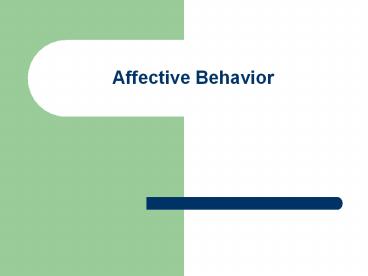Affective Behavior Affective behavior refers to emotion - PowerPoint PPT Presentation
1 / 11
Title:
Affective Behavior Affective behavior refers to emotion
Description:
Affective Behavior Affective behavior refers to emotion. Feelings such as anger, fear, sadness and pleasure. Those who love learning, keep on learning. – PowerPoint PPT presentation
Number of Views:38
Avg rating:3.0/5.0
Title: Affective Behavior Affective behavior refers to emotion
1
Affective Behavior
2
Affective behavior
- refers to emotion. Feelings such as anger, fear,
sadness and pleasure.
3
Those who love learning, keep on learning.
- Affective variables are excellent predictors of
students future behavior.
4
We measure what we treasure.
- What we test is what we consider important.
5
Uses of Affective Measures
- Assess enjoyment of the program
- To determine areas of interest
- To assess change in attitude
- To determine areas of disinterest
- Teacher/student match
- Motivation
- Reducing anxiety
6
Ways to give the affective test.
- Select non-controversial attitudes to test.
- Guarantee anonymity for the students.
- Use only checkmarks or Xs.
- Have students collect the questionnaires.
- Dont call it a test (call it a questionnaire).
- Dont hover around students while they are
testing. - Assess at beginning of the year and again at the
end.
7
Types of Measures
- Rating scales
- Forced-choice inventories
- Questionnaires
- Likert scale
- Semantic differential scale
- Perceived exertion scale
8
Information regarding students affect can help
teachers teach more effectively on a day-to-day
basis.
- If you discover students are bored and
disinterested in the content youre presenting,
then you can change the lesson.
9
Content
- 20-30 statements.
- 3 points for a positive answer.
- 2 points for unsure.
- 1 point for agreeing with a negative statement or
disagreeing with a positive statement. - Higher score more positive
- Lower score less positive
10
- Each variable must be represented by a positive
and a negative statement.
11
Your students will benefit now and in the years
to come!































